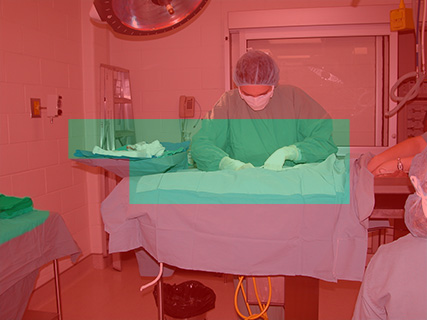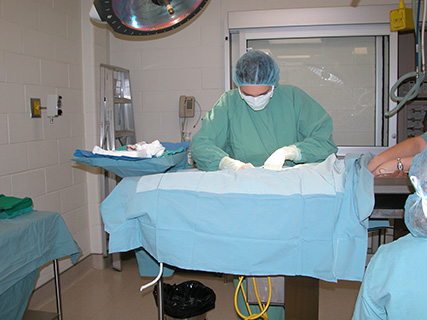- Shows green for sterile area and red for contaminated areas
- When surgeon gowned and gloved and draping completed, the sterile field consists of:
- area above draped table edge
- up to 5 cm of where drape contacts nonsterile surface (ideally table edge)
- surgeon’s front below shoulders but above waist or table
- any double draped table (eg. instrument table or mayo stand)
GOLDEN RULE: If you recognize a break in sterile technique, recognize it and CORRECT it immediately!
General Principles
- Keep sterile things (eg. hands, instruments) within the sterile field and contaminated items outside.
- When moving: turn sterile towards sterile and contaminated towards contaminated
- Microorganisms ARE in the air and WILL settle on the incision and surgical field. It is just a matter of time before sufficient numbers accumulate to cause an infection. Minimize surgical time and air currents.
- Antibiotics are NOT a substitute for poor aseptic technique.
- General guidelines
- want effective against most likely contaminants (usually Staph spp)
- give intravenously so reach high tissue levels quickly
- give 30 minutes before skin is incised so have high tissue levels during surgery
- repeat every 90-120 minutes depending on drug’s half life so high tissue levels are maintained
- discontinue after the incision is closed
- When used outside these guidelines, antibiotics do not decrease infection rates
- Antibiotics continued for > 12 hours after surgery are associated with higher infection rates
- Improper use of prophylactic antibiotics contributes to multi-resistant bacteria and hospital acquired infection with multi-drug resistant bacteria
Keep your hands within the sterile field (not below table, near face (no itching), keep together at mid chest when outside sterile field


Straight through so sides face sterile field.
Turn sterile front to sterile area and back to contaminated area.
Avoid as can’t protect sterile field.
Prepare ahead of time by reviewing anatomy, steps of procedure and how to avoid potential complications. Ensure everything is ready and think ahead as you are performing each step. Minimize talking and traffic within the operating room as each is associated with increased infection rates.
This is referred to as prophylactic antibiotics (therapeutic antibiotics involve treating an infection that is present).


